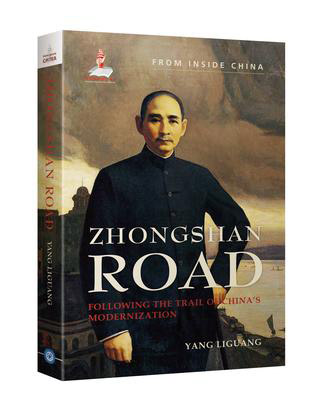Poetic Narration & Philosophical Wisdom
IN China, it is not uncommon to name a road after a person. According to incomplete statistics, among China’s provinces, municipalities, and autonomous regions, including Taiwan, 326 roads have been named in the memory of Dr. Sun Yat-sen, with 187 named “Zhongshan Road.” This is a unique phenomenon worldwide.
Though the time and location of these roads vary, almost every one is situated at the heart of the city, the most prosperous area, displaying the city’s current landscape and reflecting its age-old history. They are built for long-lasting memories, inheriting the spirit of Sun Yat-sen and his undertakings from generation to generation.

Zhongshan Road: Following the Trail of China’s Modernization
Author: Yang Liguang Paperback, 413 pages Published by Aurora Publishing LLC
“’Zhongshan Road’ is both the historical testimony to China’s road toward modernization, and also to unique phenomena reflecting its history, culture, and economy. ‘Zhongshan Road’ is a narration of history, the hardships and the intricacies of China’s modernization,” explained Yang Liguang, author of the book Zhongshan Road: Following the Trail of China’s Modernization, vice-president of the Chinese Reportage Association, editor-in-chief of Shenzhen Evening News, and senior journalist.
The book comprises 12 chapters. It starts with the shortcuts and wrong turns of two worlds in 1514 when the East and the West – developed along diverging paths. Twelve pivotal moments of Chinese history, especially after the Opium War, are included: the fall of an autocracy in 1840; Sun Yat-sen’s journey from Guangdong’s Xiangshan in 1894; pioneers at home and abroad discovering a new way in 1905; China at the crossroads following the Wuchang Uprising in 1911; the establishment of the Republic of China in 1912; the May 4th Movement in 1919; Guangzhou’s tough path in 1924; Sun Yat-sen’s death in Beijing in 1925; the tyrannical rule of the Kuomintang in 1929; the founding of the People’s Republic of China in 1949; the initiation of the first Five-Year Plan in 1953; and the reform and opening-up policy adopted in late 1978, which led China into a new world.
Following the trail of China’s modernization over the past century, the author reaches a foregone conclusion: the road that the Communist Party of China leads all Chinese people along is exactly that to China’s modernization and the nation’s rejuvenation, as pursued wholeheartedly by Sun Yat-sen throughout his life.
China’s history is so complicated that the author hopes to provide different perspectives.
From a Western perspective, China remains a land of mystery. “If we observe its development and affairs at face value in the paradigm of a Western reality, it is impossible to fathom the sheer pace of China’s industrialization. This book gives insight into not only the historical events that have shaped China, but also the Chinese mindset and the ideology that continues to shape China today. An insight into the past century of revolutionary events, more importantly, it demystifies thousands of years of culturally ingrained ideology and unrealized developments that made it not only possible, but inevitable.”
In a certain sense, the history of China’s modernization is the history of modern Chinese people. Those torchbearers represented by Sun Yat-sen, therefore, become historical facilitators and “Zhongshan Road” has become a simple memorial to the past.
As the author said, “Only by peering through the darkness of history can one sincerely cherish the brightness of today’s sunshine and confidently look to the future.”
As non-fiction literature, the book is filled with poetic narration and philosophical wisdom. Yang Liguang said, “It is a serious task to rethink China’s modernization, but also an alluring thing for me, as our aspirations and feelings are reflected between the lines.”
Yang explained that he was inspired by one of Qiu Shuhong’s poems entitled Zhongshan Road:
You are the city’s lifeblood, the memory of a nation; you are the city’s family tree, the legend of a nation; you are the city’s aspiration, the will of a nation; you are the city’s yearning, the hope of a nation.
“I transposed this lyric poetry into the narrative of the book,” Yang said.
At the same time, the book is a reflection on Chinese wisdom. Yang combs through every detail of 20th century historical materials, most of which are well-known and shared documents on revolutionary history. He links them with certain historical landscapes: “Major historical events are reflected in every detail so as to present the reality of history.”
“Zhongshan Road is an authentic road, and also a symbol of the spirit of modernization. Starting from Cuiheng Village in Guangdong Province, Sun Yat-sen’s hometown, it bears witness to the achievements and glory of today, and also to the confusion, humiliation, struggle and striving of Chinese people in the past century.”
